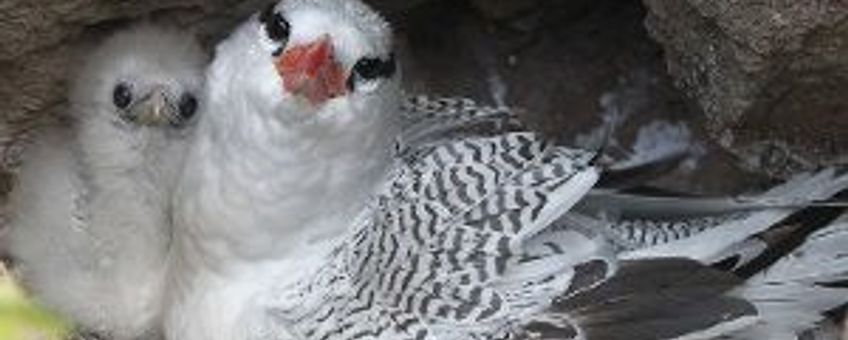
Kat gevaar voor tropische keerkringvogel op St. Eustatius?
Bericht uitgegeven door Dutch Caribbean Nature Alliance (DCNA) [land] op [publicatiedatum]
De St. Eustatius National Park foundation (STENAPA) is een project gestart om het predatierisico op de tropische keerkringvogel (Phaethon aethereus) te bepalen en het broedsucces van de vogels te vergroten. In 2011 bleek dat verwilderde katten een grote bedreiging vormen voor de tropische keerkringvogel op Saba. Omdat de grootste Caribische broedpopulaties van de soort zich bevinden op St. Eustatius en Saba, wil STENAPA graag weten of dit op St. Eustatius ook het geval is. Op dit eiland legden camera’s al de aanwezigheid van verwilderde katten in de buurt van tropische keerkringvogelnesten vast, maar het is nog te vroeg om te zeggen of de vogels hier hetzelfde risico lopen als op Saba. Als dit zo is, zal STENAPA stappen ondernemen om de verwilderde kattenpopulatie te verkleinen. Daarnaast gaat de stichting onderzoeken of ook ratten een rol spelen bij de predatie van de vogels.
Lees verder in het Engels....
 In January 2013 the St. Eustatius National Park foundation (STENAPA) started a seabird monitoring project, thanks largely to a small grant by the Society for the Conservation and Study of Caribbean Seabirds (SCSCB), which emphasises on Red-billed Tropicbirds (Phaethon aethereus). The project is managed by National Park Ranger Hannah Madden and intern Andrew Ellis, with the weekly assistance of two dedicated high school students. The aim is to assess the risk of predation on tropicbirds and establish the nesting success of this species. This involves visiting three nesting sites per week to measure and weigh chicks, as well as banding adults and chicks as part of a long-term research project.
In January 2013 the St. Eustatius National Park foundation (STENAPA) started a seabird monitoring project, thanks largely to a small grant by the Society for the Conservation and Study of Caribbean Seabirds (SCSCB), which emphasises on Red-billed Tropicbirds (Phaethon aethereus). The project is managed by National Park Ranger Hannah Madden and intern Andrew Ellis, with the weekly assistance of two dedicated high school students. The aim is to assess the risk of predation on tropicbirds and establish the nesting success of this species. This involves visiting three nesting sites per week to measure and weigh chicks, as well as banding adults and chicks as part of a long-term research project.
A Red-billed Tropicbird monitoring workshop in 2011 run by conservation ecologist, and DCNA scientific advisor, Dr. Adrian Delnevo, found no breeding success for the Red-billed Tropicbird at several nesting colonies on Saba. Cameras set up outside nests captured photos of predating feral cats. The skills learned during the 2011 workshop have since then been applied to monitor this species on Saba and St. Eustatius. This combined with other information will be used to develop a coordinated conservation strategy for the Red-billed Tropicbird.
 Given that Saba and St. Eustatius are home to the Caribbean’s largest nesting population of Red-billed Tropicbirds, STENAPA deemed it necessary to determine the risk of predation on St. Eustatius’ own Red-billed Tropicbirds. DCNA loaned STENAPA two cameras, which have been strategically placed outside active nests containing a young chick. Within just a few days one of the cameras photographed a cat outside one of the nests. It is too early to say whether the tropicbirds on St. Eustatius face the same risk of predation as those on Saba; data is still being collected and the results of this six-month study will be available in June. If predation rates prove to be high, STENAPA will take steps to control the feral cat population by working with the animal welfare foundation to sterilise/neuter or euthanise the animals. As well as cats, it is believed that rats may also play an important role in predation; live traps will be set up at nesting sites in an attempt to confirm this. It is hoped that the long hours and hard work invested in this project will bring interesting and encouraging results for the only species of seabird known to nest on St. Eustatius.
Given that Saba and St. Eustatius are home to the Caribbean’s largest nesting population of Red-billed Tropicbirds, STENAPA deemed it necessary to determine the risk of predation on St. Eustatius’ own Red-billed Tropicbirds. DCNA loaned STENAPA two cameras, which have been strategically placed outside active nests containing a young chick. Within just a few days one of the cameras photographed a cat outside one of the nests. It is too early to say whether the tropicbirds on St. Eustatius face the same risk of predation as those on Saba; data is still being collected and the results of this six-month study will be available in June. If predation rates prove to be high, STENAPA will take steps to control the feral cat population by working with the animal welfare foundation to sterilise/neuter or euthanise the animals. As well as cats, it is believed that rats may also play an important role in predation; live traps will be set up at nesting sites in an attempt to confirm this. It is hoped that the long hours and hard work invested in this project will bring interesting and encouraging results for the only species of seabird known to nest on St. Eustatius.
Besides monitoring tropicbirds, the project also aims to confirm the presence of Audubon’s Shearwater (Puffinus lherminieri, NL Audubons pijlstormvogel). This is a nocturnal seabird that is thought to nest in the cliffs of the northern hills of St. Eustatius, but its presence has long since been confirmed. In order to determine its presence now, the team will have to go out at night with a playback device and play the call of the bird repeatedly to lure them into answering the recording, since Shearwaters tend to be most active around midnight.
For more information: read the article Conservation Science: Red-billed Tropicbirds on Saba and St. Eustatius.
Text: Hannah Madden, STENAPA
Pictures: Michiel Boeken; STENAPA
Nederlandse inleiding: Sara Mulder, De Natuurkalender
